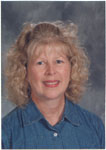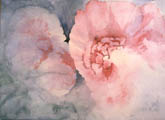faye tambrino 
marshalltown, iowa | interviewed 2-26-2002
biographical sketch | artist's statement | interview clips

"Dreams of the Future"
painting
(click image for larger view)
copyright © 2001 Faye Tambrino | All Rights Reserved
interview clips (mp3 audio & text)
Metamorphosis would be a good word for how, I guess, we all work and change. I really strive in my work to become less uptight and more flowing and natural, and I think I have been able to do that a little more. I think I was more structured and fussy early on, and I've become more relaxed and natural, and able to capture what's happening accidentally with the media—which is just my joy—rather than trying to force something on it.
I was on my way to a team meeting at school, and everybody was gathering around the TV. We didn't have our meeting. We watched the news for quite awhile, and we were just all kind of in shock, I guess, like everywhere else. But then it was really weird to go back to the classroom, and try to get through the rest of the day working with the kids, and trying not to get them too overwhelmed with this news, and yet to make them aware of the seriousness of the situation. It wasn't till I went back to lunch and we're watching TV at lunchtime that I saw the collapse of the buildings, and that was really almost more than a person wants to take during the middle of a workday.
I have a stepson that works in New York, and my first concern was, where is he? What's he doing? Turned out, he was to be in the World Trade Center the very next morning. So, we were just so grateful that that timing was how it was. But my first thought was about him, and about other people I know in the New York area. It isn't likely that anybody I know was in those buildings, but you personalize.
We did stop from our work and talk about it in every class. I think the kids from the Midwest who didn't have any relatives in New York or anything, think of New York, sometimes, as very far away, and almost like a foreign country, and they didn't relate. I think they have much since then, but I think their initial reaction was, This doesn't have anything to do with me; it's not a big deal—which is really scary, or it seemed like it to me. I went through a real range of emotions dealing with kids those days, because they were saying odd and stupid things it seemed like. So you wanted to relax and talk with them about it a little bit. This is important because…, and this will not overwhelm us because….
My idea was future. You know, I was working on three or four paintings at the time, and one was very ashy; I called it something about ashes. And this was like, you know that song about the rose blooming in the spring—Bette Midler's "Rose"? And I was thinking about that song and how things can seem so grim and so dismal at times. And yet, if you can keep that vision of—it may get worse before it gets better, but it's going to get better.
I wanted it to be kind of a shadowy image that left something to the imagination, like our futures all are. And yet, a rosy future sounds a little trite. But you have to think that the best is yet to come, and that we have a glorious future awaiting us in this country. And that little floral image—that's what it means to me.
I haven't put a flag on my car, but I don't resent those who have. When you're at an athletic event and they're singing the national anthem, you're thinking a lot more about what it means to be an American than you did a year ago—I think you'd have to have your head in the ground if you didn't. You spend a little more time appreciating your freedoms and thinking about how would it be if I were living some place else. We take all these things so for granted. Even as diverse as we are, we can still be Americans and know what that means to have the freedoms we have. And a lot of people say, "Well, we don't mind giving up a few of these freedoms in order to feel safe," and yet, that's very tense conversation, because we love our freedoms, and we may not appreciate them fully all the time until we see the flip side of that. But then we do see and understand and realize how important it is to be able to wave your flag and to present your painting.
biographical sketch
Faye Tambrino was born in 1944 in Thief River Falls, Minnesota, where she also grew up. She was the second of four children.
She attended Concordia Colleges in St. Paul, Minnesota, and Seward, Nebraska, and received a B.S. in art education from the University of Minnesota. She and her family moved to Iowa in the 1970s, living in Manly, Jefferson, Waverly, and now Marshalltown. She started teaching part-time when her two children were school-age, and that eventually became full-time. She earned her M.A. in Educational Administration at the University of Northern Iowa, Cedar Falls.
She teaches middle school art in Marshalltown, where she has lived with her husband since 1994. She works mostly in watercolor. She also occasionally teaches watercolor workshops for adults.
artist's statement (general)
As a visual arts educator, I attempt to make students aware of the importance of the visual world, and their part in it. Even though most visual arts classes are taught as separate entities, it is important that students see the arts as an integral part of life.
The most important aspect of my teaching is creative problem solving. I use brainstorming sessions, mind mapping webs, and other idea gathering techniques to explore the widest range of possibilities before focusing on a specific plan. Flexibility is another important part of creativity. My students are always encouraged to look for alternate options. Often an accident will force a creative alternative.
Another vital aspect of my teaching is that of making connections with the history of art, and other cultures. It is also important that students develop an art vocabulary, and are able to discuss how the elements and principles of design work within a piece of art.
As an artist, I prefer working in watercolor, and occasionally venture into the gouache and acrylic media as well. My favorite subjects are forms from nature; however I enjoy beginning most of my paintings without a plan, and allowing the media to suggest ideas to me.



